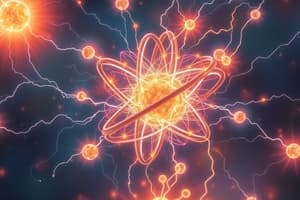Podcast
Questions and Answers
What is the charge of a neutron?
What is the charge of a neutron?
No charge
What is the formula to find the energy of a charged particle in an electric field?
What is the formula to find the energy of a charged particle in an electric field?
E = qV
What is the energy gained or lost by an electron when it moves through a potential difference of 1 V?
What is the energy gained or lost by an electron when it moves through a potential difference of 1 V?
1 eV
What is the charge of an electron in coulombs?
What is the charge of an electron in coulombs?
What is the formula for the energy of an electron in an electric field, given the voltage across the field?
What is the formula for the energy of an electron in an electric field, given the voltage across the field?
In an electric field, what type of energy is converted to kinetic energy as an electron moves through it?
In an electric field, what type of energy is converted to kinetic energy as an electron moves through it?
What is the effect of increasing the voltage across an electric field on the kinetic energy of a charged particle?
What is the effect of increasing the voltage across an electric field on the kinetic energy of a charged particle?
What is the relationship between the mass of a particle and its velocity in an electric field?
What is the relationship between the mass of a particle and its velocity in an electric field?
What is the result of an electron moving through an electric field with a constant voltage?
What is the result of an electron moving through an electric field with a constant voltage?
What is the minimum energy required to remove the loosest electrons from the surface of a metal, and what is it referred to as?
What is the minimum energy required to remove the loosest electrons from the surface of a metal, and what is it referred to as?
What is the purpose of heating the metal filament in a cathode ray tube, and how does it contribute to the formation of an image on the screen?
What is the purpose of heating the metal filament in a cathode ray tube, and how does it contribute to the formation of an image on the screen?
What is the force experienced by an electron moving through a magnetic field, and how is it related to the charge, velocity, and magnetic flux density?
What is the force experienced by an electron moving through a magnetic field, and how is it related to the charge, velocity, and magnetic flux density?
What is the result of an electron striking the fluorescent material in a cathode ray tube, and what type of energy conversion occurs?
What is the result of an electron striking the fluorescent material in a cathode ray tube, and what type of energy conversion occurs?
What is the significance of the work function in determining the energy required for thermionic emission, and how does it relate to the energy of the particles on the surface of the metal?
What is the significance of the work function in determining the energy required for thermionic emission, and how does it relate to the energy of the particles on the surface of the metal?
What is the main hazardous effect of X-rays in medical applications?
What is the main hazardous effect of X-rays in medical applications?
What is the purpose of the vacuum in an X-ray tube?
What is the purpose of the vacuum in an X-ray tube?
What is the Photoelectric effect, and what causes it?
What is the Photoelectric effect, and what causes it?
What is a photon, and what type of energy does it represent?
What is a photon, and what type of energy does it represent?
What is the material used as the target in an X-ray tube, and why is it suitable?
What is the material used as the target in an X-ray tube, and why is it suitable?
What is the relationship between the energy of a photon and the frequency of the electromagnetic radiation associated with it?
What is the relationship between the energy of a photon and the frequency of the electromagnetic radiation associated with it?
When photons strike metal, what happens to the energy of the photon that exceeds the work function?
When photons strike metal, what happens to the energy of the photon that exceeds the work function?
What is the role of Planck's constant in the equation E = hf?
What is the role of Planck's constant in the equation E = hf?
What determines the energy required to remove an electron from the surface of a metal?
What determines the energy required to remove an electron from the surface of a metal?
What is the energy of a photon composed of?
What is the energy of a photon composed of?
What is the physical significance of the threshold frequency (f0) in the photoelectric effect?
What is the physical significance of the threshold frequency (f0) in the photoelectric effect?
What is the relationship between the work function of a metal and the energy of the photons required to emit electrons?
What is the relationship between the work function of a metal and the energy of the photons required to emit electrons?
What determines the maximum velocity of the emitted electrons in the photoelectric effect?
What determines the maximum velocity of the emitted electrons in the photoelectric effect?
What is the role of Planck's constant in the equation hf = ϕ + 1/2 m v_max^2?
What is the role of Planck's constant in the equation hf = ϕ + 1/2 m v_max^2?
What is the significance of the term 1/2 m v_max^2 in the equation hf = ϕ + 1/2 m v_max^2?
What is the significance of the term 1/2 m v_max^2 in the equation hf = ϕ + 1/2 m v_max^2?




